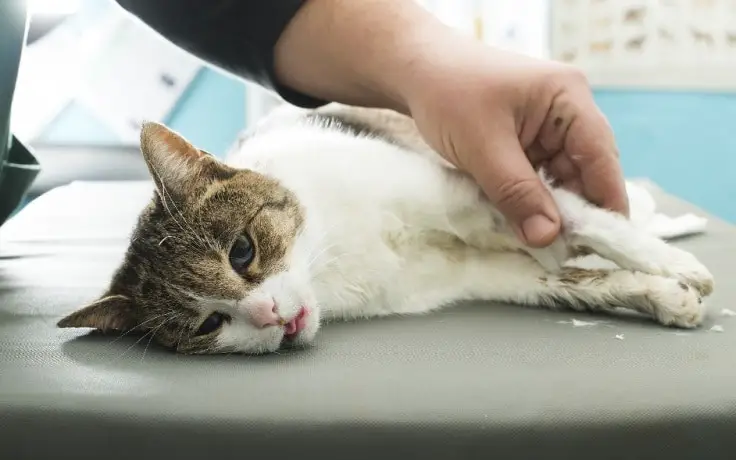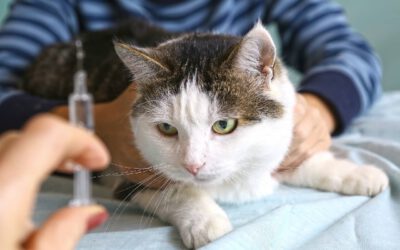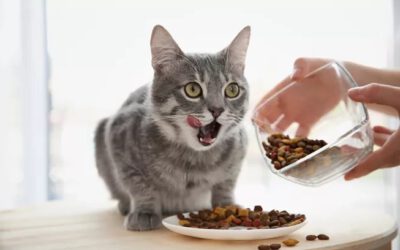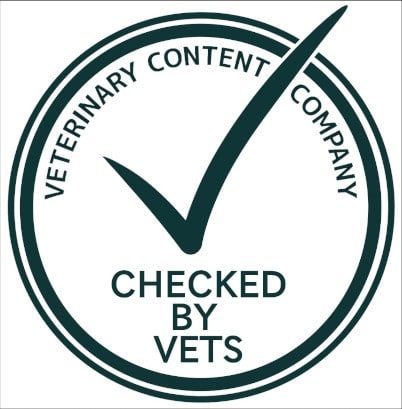
The information in this article has been checked for medical accuracy by an experienced veterinarian (Dr. Joannna Woodnutt). However, this information is not meant to be used as a substitute for diagnosis or advice from your local vet.
Cats are born into the world full of energy. But once they grow up and reach the age of senior, the process of deterioration starts: tissues, muscles and nerve cells become less efficient over time. In this article we are discussing chronic kidney disease (CKD), a term for the irreversible deterioration of the kidney filtration system.
Why Cats Have Kidneys
Every mammal is born with two kidneys. These organs filter the blood in an effort to remove all the metabolic waste-products that are being discharged by the body’s cells into the bloodstream. This filtrate is then mixed with excess fluids leaving the body and is finally expelled as a yellow liquid substance: urine.
This process is crucial to the maintaining of many chemical balances in our body. In particular, the amount of water, salts, acids and potassium in the cells are being regulated by the kidneys. Some other key functions of this organ system:
- produce hormones that regulate blood pressure
- produce an active form of vitamin D (necessary for creating strong bone tissue)
- control the production of red blood cells
The kidneys are also able to respond to dehydration by concentrating urine and returning some of the water to the body.
As you can guess from this list, the kidneys are some of the most vital organs in our bodies. Without them, we have no chance of maintaining a healthy balance in many processes.
What Is Chronic Kidney Disease?
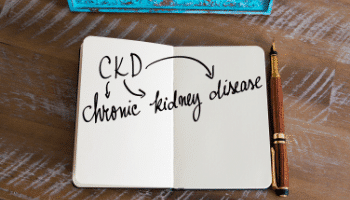
Baby kittens are almost always born with a very strong set of kidneys that have a large filtration capacity. In fact, new kidneys have so much power that whenever one part is damaged, some other unused part of the organ is able to take over.
But as cats grow older, this buffer will eventually be used up. Once that point is reached, the kidneys will slowly start to lose their filtration capacity over time.
Whilst this loss of capacity is to some extent ‘normal’, for some pets the damage becomes so severe that hey kidneys cannot function properly. ‘Chronic Renal Failure’ or ‘Chronic Kidney Injury’ are other names for the severe loss of kidney function over time. We call the disease ‘chronic’, because it happens over a long period, with small amounts of damage slowly building up.
Deterioration of the organs is not an overnight process. CKD is mostly diagnosed in cats past the age of seven, because it takes several years before the damage has progressed to a level where symptoms start to become visible on the outside.
By that time almost 75% of your cat’s kidney function will have been permanently lost. It is therefore vital that older pets are checked at least once a year by the vet in an effort to discover diseases like CKD as soon as possible.
What affects the progression of CKD?
Other factors besides age can influence the progression of kidney disease: breed, diet choice (notably phosphorus levels), daily activity, and the presence of other diseases. Because CKD tends to develop over a period of years rather than months, it’s almost impossible to point to the exact cause in most cases.
Chronic renal failure is another name for this loss of kidney function that naturally comes with aging. The word chronic means “never ending”, because there is currently no known way to reverse chronic kidney disease. However, many other factors beside age can influence the progression of kidney disease: breed, diet choice (notably phosphorus levels), daily activity, other diseases and so on.
Four Stages Of Chronic Kidney Disease
- Stage 1: The kidneys operate at 60% of their original capacity. If detected at this point, chances of succesful treatment are significantly larger.
- Stage 2: In medical terms, failing kidneys are officially diagnosable once the kidneys’ capacity is down to 35% of its’ original healthy state. The kidneys are now no longer able to maintain sufficient levels of vitamins and minerals in the blood. At this point your cat will start t0 appear ill and will likely be thirsty all the time as a result of the increased urine production.
- Stage 3: With the kidneys down to only 25% capacity, toxins start to build up in the body and symptoms become more severe. On average, cats in this stage will survive for two more years.
- Stage 4: Cats with severe chronic renal disease will eventually move into the final fourth stage. Now unable to drink enough water to compensate for fluid loss, a cat in stage 4 is suffering from severe dehydration. Toxicity symptoms are also present due to the high concentration of wasteproducts built up in the body’s tissues. If left untreated, the average life expectancy of a cat in stage 4 CKD is about 30 to 40 days.
Symptoms Of Renal Failure
As we explored in previous sections, a malfunctioning renal system will no longer be able to prevent waste materials from reaching toxic concentrations in the body. The kidneys’ initial respons to this crisis is to produce more urine in an effort to keep up. One of the first things you could notice in your cat as a result is more frequent urinating (polyuria).
At this point the cat will also need to drink more often (polydipsia) to compensate for the larger amount of urine being discharged. This entire process of increased urine production and fluid intake is also known as compensated renal failure.
Other side-effects of extra toxins in the body are loss of appetite, weight loss and an unhealthy looking fur. The accumulation of waste products may also make a cat feel ill and letargic.
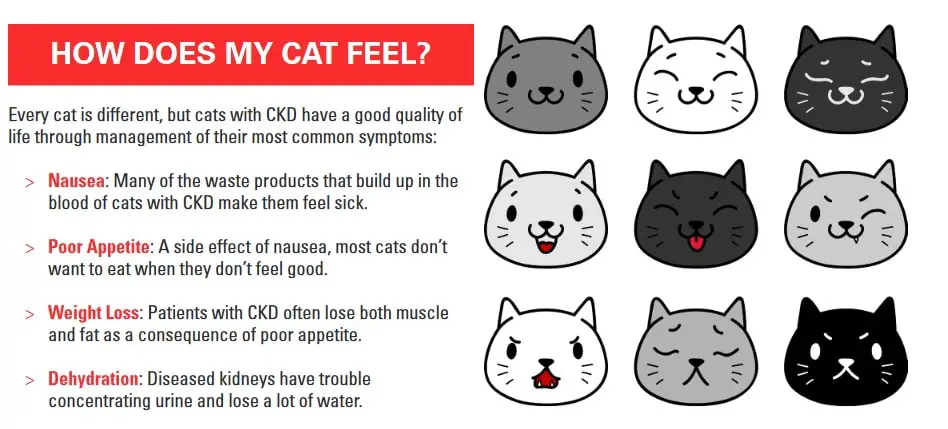
As the disease progresses through later stages, many other aspecific symptoms may appear. Watch this video to get a full understanding of the possible symptoms that can result from renal failure:
Consquences if left untreated
Stage 4 kidney failure will eventually have very severe and painful consequences for your cat. The accumulation of toxic concentrations can result in:
- abnormally high urea and creatine levels
- an unhealthy increase in blood-pressure
- many more unpleasant effects, possibily even seizures and heart attacks
Although this outlook is not very pleasant, there are fortunately many examples of cats that manage to live long and happy lives after diagnosis. Even those with high bloodwork values.
Diagnosis and blood tests
CKD is usually diagnosed by analysing blood and urine samples. Chronic kidney disease was traditionally tested by measuring microalbuminuria (small proteins in urine) and the levels of two natural byproducts of kidney function in the blood: creatinine and blood urea nitrogen. The levels of these substances will typically be elevated in the case of CKD.
Since hypertension is a relatively common symptom of kidney disease, your vet will also likely want to measure your cat’s blood pressure.
Unfortunately, with these methods an early diagnosis of renal failure is not possible; rises in blood urea nitrogen & creatinine were only measurable after significant loss of kidney function had occurred.
Early detection
A recently developed test that measures levels of SDMA (symmetric dimethylarginine, another indicator for kidney function) can be used to determine if early renal failure is occurring. Although this method looks very promising, it is currently only being used alongside traditional kidney activity tests to get the most accurate results.
The concentration of white & red blood cells may also prove useful in early detection of CKD, determining the extent of the damage and subsequently deciding on the best course of treatment.
As your cat begins to grow old, yearly veterinary check-ups become important to maximise the chance of early detection. A declining urine concentration or body weight may be early signs that CKD is developing. The earlier discussed blood tests may also prove useful in early detection of CKD.
Treatment
Treatment of kidney disease will vary depending of the severity of symptoms. While there is sadly no definitive cure for CKD, a proper treatment plan can go a great length towards slowing down the progression of this disease and increasing quality of life by reducing symptoms. Treatment will likely include introducing the cat to a special CKD diet and may also involve additional supplementation. It is crucial that the treatment is based on recent test results and tailored to a cat’s current situation.
CKD treatment is focussed on minimizing the buildup of toxic waste products in the bloodstream and combating the various side-effects of these elevated waste products. CKD diets focus on these key areas:
- adequate hydration
- manage disturbed electrolyte concentration
- controlling blood pressure
Changing to a food low in protein and phosphorus may also take some pressure off the kidneys by lowering the amount of metabolic waste products entering the bloodstream. Phosphate levels can be further reduced by giving binders such as aluminium hydroxide. These will actively bind with any phosphate in the blood.
Potassium is often given in the form of a supplement because malfunctioning kidneys tend to remove too much potassium from the blood.
Sometimes high blood pressure can occur as a result of CKD, which over time can cause even more damage to the kidneys. When this is no longer manageable through diet, your vet should prescribe a medicine to lower the blood pressure to more acceptable levels.
Prognosis for cats with CKD
Contrary to acute renal problems, chronic problems are almost always progressive. Meaning there is very little chance of a full recovery. The bodies’ compensatory changes will fail at some point. However, despite the fact that CKD gets worse over time, a diagnosis does not nescessarily mean that your can’t live a happy life in the coming years.
Effective treatment and diet changes can both slow down progression of CKD and increase your cats’ quality of life. Of course, the potential effect of a treatment will depend on the amount of kidney damage that has occured prior to diagnosis.
Life expectancy per stage:
The sooner kidney failure is treated, the better your cat’s chances of survival. The most recent studies show the following average survival rates for each stage:
Stage 1 & 2: 4 years
Stage 3: 1.8 years
Stage 4: only 1 month
Prevention
Probably one of the best lines of defense against CKD is maintaining a high-quality balanced diet, meaning it contains enough animal-sourced protein & liquids, and does not go overboard on fat and salts. When your cat has diabetes or high blood pressure, managing those will also help tremendously in preventing future kidney problems. Other preventative measures:
- Daily excercise: Play with your cat and let it run around as often as possible
- Kidney stress gets worse as a consequence of poor water quality and dehydration. Make sure your cat is drinking enough.
- Switch over to wet food if you haven’t already. Dry kibble sucks up a lot of moisture in the body, putting more stress on the kidneys
- Regular check-ups with the vet can help detect problems at an early stage before they become more serious
- Include krill oil in your cat food. Research has shown that krill oil helps slow down the deterioration of organs
- Add probiotics to the diet. They help to eliminate toxins from the body.
- Maintain a low-stress environment. Easier said than done, but try your best.
Frequently Asked Questions:
In chronic disease, progression from stage 1 to stage 4 generally takes at least a few years. There is unfortunately no way of stopping the progression of this disease. However, with a proper treatment plan, the progression can be slowed down a great deal and your cat could have many good years ahead.
In contrast, AKF (Acute Kidney Failure), which for example can occur as a result of your cat chewing on the highly dangerous lily plant, is more of an immidiate threat. It can become fatal in as little as three days.
According to studies, over one-third of all cats will get some form of kidney disease during their lifetime, and 50% of cats over the age of 15 are suffering from it.
While this article mainly described kidney disease as a consequence of aging, the kidneys
can also suddenly stop functioning as a result of severe poisoning.
The symptoms in ARF are the same as in chronic disease. Be mindful if your cat shows the symptoms listed in previous sections. Acute kidney disease is often fatal if not agressively treated in a clinic.
Once a vet a has diagnosed chronic renal problems in your cat, he or she will almost certainly recommend certain CKD foods or diet changes to reduce stress on the kidneys. These foods havea custom tailored nutrient-content that is designed to reduce CKD symptoms and can go great lengths towards increasing your cat’s quality of life in the coming years.

